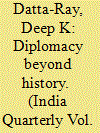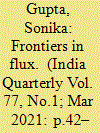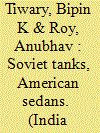|
|
|
Sort Order |
|
|
|
Items / Page
|
|
|
|
|
|
|
| Srl | Item |
| 1 |
ID:
176990


|
|
|
|
|
| Summary/Abstract |
The history of Indian diplomacy conceptualises diplomacy racially—as invented by the West—and restrictively—to offence. This is ‘analytic-violence’ and it explains the berating of Indians for mimicking diplomacy incorrectly or unthinkingly, and the deleting, dismissing, or denigrating, of diplomatic practices contradicting history’s conception. To relieve history from these offences, a new method is presented, ‘Producer-Centred Research’ (PCR). Initiating with abduction, an insight into a problem—in this case Indian diplomacy’s compromised historicisation—PCR solves it by converting history’s racist rationality into ‘rationalities’. The plurality renders rationality one of many, permitting PCR’s searching for rationalities not as a function of rationality but robust practices explicable in producer’s terms. Doing so is exegesis. It reveals India’s nuclear diplomacy as unique, for being organised by defence, not offence. Moreover, offence’s premise of security as exceeding opponent’s hostility renders it chimerical for such a security is, paradoxically, reliant on expanding arsenals. Additionally, doing so is a response to opponents. This fragments sovereignty and abdicates control for one is dependent on opponent’s choices. Defence, however, does not instigate opponents and so really delivers security by minimising arsenals since offence is eschewed. Doing so is not a response to opponents and so maintains sovereignty and retains control by denying others the right to offense. The cost of defence is courage, for instance, choosing to live in the shadow of nuclear annihilation. Exegesis discloses Balakot as a shift from defence to offence, so to relieve the Bharatiya Janata Party’s (BJP) leadership of having to be courageous. The intensity of the intention to discard courage is apparent in the price the BJP paid. This included equating India with Pakistan, permitting it to escalate the conflict, and so imperiling all humanity in a manner beyond history.
|
|
|
|
|
|
|
|
|
|
|
|
|
|
|
|
| 2 |
ID:
176992


|
|
|
|
|
| Summary/Abstract |
On the eve of Indian Independence, as Britain prepared to devolve the Crown’s treaties with Tibet to the Indian government, the Tibetan government was debating its future treaty relationship with India under the 1914 Simla Convention and associated Indo-Tibetan Trade Regulations. Soon after Indian independence, Tibetan government made an expansive demand for return of Tibetan territory along the McMahon Line and beyond. This led to a long diplomatic exchange between Lhasa, New Delhi and London as India deliberated its response to the Tibetan demand. This article decodes the voluminous correspondence between February 1947 and January 1948 that flowed between the British/Indian Mission in Lhasa, the Political Officer in Sikkim, External Affairs Ministry in Delhi and the Foreign Office in London, on the Simla Convention and the ensuing Tibetan territorial demand. Housed at the National Archives in New Delhi, this declassified confidential communication provides crucial context for newly independent Indian state’s relationship with Tibet. It also reveals the intricacies of Tibetan elite politics that affected decision-making in Lhasa translating to a fragmented and often contradictory policy in forging its new relationship with India. Most importantly, this Tibetan territorial demand undermined the diplomatic efficacy of Tibet’s 1947 Trade Mission to India entangling its outcome with the resolution of this issue. This was a lost opportunity for both India and Tibet in building an agreement on the frontier which worked to their mutual disadvantage in the future.
|
|
|
|
|
|
|
|
|
|
|
|
|
|
|
|
| 3 |
ID:
176993


|
|
|
|
|
| Summary/Abstract |
The first British application to join the European Economic Community (EEC) in July 1961 came at a time when India confronted an acute foreign exchange crisis and chronic trade deficits and when it was heavily dependent on the UK as a major market. Unlike the widely held belief, this article argues that India engaged Community institutions in a proactive and calibrated manner from the outset till de Gaulle vetoed British membership in January 1963. It highlights the crucial role of the Indian Mission in Brussels and its first ambassador to EEC in efforts to seek redressal of Indian concerns and secure a viable trade arrangement with the Community.
|
|
|
|
|
|
|
|
|
|
|
|
|
|
|
|
| 4 |
ID:
176994


|
|
|
|
|
| Summary/Abstract |
Literature in Diplomatic Studies often reference a phenomenon where diplomats sent for too long to another country develop an affinity for their assigned country, sometimes to the detriment of their home country. This has profound implications when we examine diplomatic agents as personalities in their own right and their ability to perform as state agents. This article investigates the basis of such a claim by examining the Indian diplomatic corps as a case study to verify its validity and enlist the factors that influence this phenomenon. This article relies on interviews given by former diplomats of the Indian Foreign Service to highlight the structures that influence behaviour of diplomatic agents and the implications it may have on training for future diplomats and preparing them for the evolution of diplomacy in the technological age.
|
|
|
|
|
|
|
|
|
|
|
|
|
|
|
|
| 5 |
ID:
176991


|
|
|
|
|
| Summary/Abstract |
Having fought its third war and staring at food shortages, independent India needed to get its act together both militarily and economically by the mid-1960s. With the United States revoking its military assistance and delaying its food aid despite New Delhi’s devaluation of the rupee, India’s newly elected Indira Gandhi government turned to deepen its ties with the Soviet Union in 1966 with the aim of balancing the United States internally through a rearmament campaign and externally through a formal alliance with Moscow. The US formation of a triumvirate with Pakistan and China in India’s neighbourhood only bolstered its intent. Yet India consciously limited the extent of both its balancing strategies and allowed adequate space to simultaneously adopt the contradictory sustenance of its complex interdependence with the United States economically. Did this contrasting choice of strategies constitute India’s recourse to hedging after 1966 until 1971, when it liberated Bangladesh by militarily defeating a US-aligned Pakistan? Utilising a historical-evaluative study of archival data and the contents of a few Bollywood films from the period, this paper seeks to address the question by empirically establishing the extents of India’s balancing of, and complex interdependence with, the United States.
|
|
|
|
|
|
|
|
|
|
|
|
|
|
|
|
|
|
|
|
|